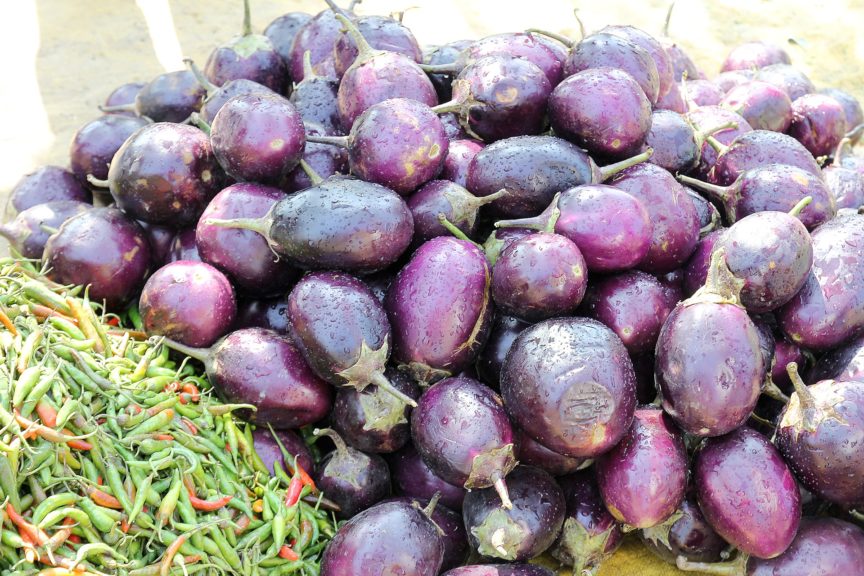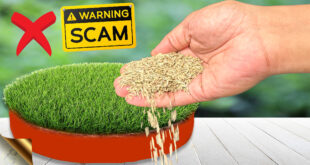In Today’s post, let look into 10 easy tips and tricks to successfully grow egg plants, also known as brinjal in containers and how to get the best harvest and the best tasting fruit.
Eggplant or Brinjal or Aubergine is a warm weather vegetable that are harvested in mid- to late summer. Whether you are growing in containers, raised beds or in ground, these tips are common for growing eggplants. You will also learn how to get the best tasting eggplants, increase yield and size of the fruit.
- CHOOSING THE VARIETY: There are many varieties of eggplant, like the Fairy tale, White eggplant, Indian eggplant, Green eggplant, Japanese, Italian and many more. The Care tips are common for all varieties of egg plants. If you want the best tasting variety – you can choose Fairy tale or the Indian Eggplant.

- SEED SOWING: Eggplant grows best in warm conditions. Right time to plant seeds is when the soil temperature is70- and 85-degrees Fahrenheit (20 to 30 Celsius). If you want to know more details on Soil temperature, please check my detailed episode on Soil temperature and vegetable planting calendar from a link in description below. Well, you can either sow the seeds directly into the main container or in a single container or seedling trays and then go for transplant. In any case, the depth of sowing should not be more than 5 to 10 mm. The seed starting mix should have at least 40 to 50% compost like vermicompost or decomposed cow dung in it. They usually germinate in 1 to 2 weeks. You can transplant these after 4 – 6 weeks.
- CHOOSING THE CONTAINER: You can easily grow eggplant in 12 to 15 inches containers. Atleast 12 inches – both in diameter and height. You can use good quality plastic pot or a cement pot or even a clay pot if available. You can also grow in fabric grow bags especially if you grow them on your terrace. These fabric bags follow the principles of air pruning which is so much beneficial to root system. Make sure there are a lot of drainage holes at the bottom of these pots. Another tip here: Choose a black coloured container if possible, because black bodies are good absorbers of heat and they do well in warm temperatures. And if you are growing in ground, better plant in raised beds for best results.
- POTTING SOIL MIX: A well-draining soil is very important for proper root growth. A stronger root system will produce a stronger and healthier shoots and yield a better harvest in the end. A simple potting mix formula should include: 40 percent garden soil, 40 percent Coco-peat or peat moss and 20 percent compost like decomposed cow dung or vermicompost. You can optionally add other stuff like perlite, neem cake powder etc if you have. You can watch a detailed episode on various potting mix recipes from links in description below. Well, In addition to this and to make the root system stronger and induce lots of flowering and fruiting, you can add one handful of steamed bone meal powder which is very inexpensive and easily available. If you are a vegan, you can add organic rock phosphate powder to the potting mix. These two organic fertilizers are very important slow release sources of phosphorous which makes the roots stronger which in turn makes the plant grow healthier and yield better by boosting the plant immune system or resistance against pests and disease. Regarding the soil PH, eggplant needs a slightly acidic soil of around 6 to 6.5 which is the ideal soil PH required for most plants.
- SUPPORT / STAKING: Once the plants begin to start growing, this is a good time to install stakes or supports to keep the plants from falling over as they load up with fruits. We will shortly discuss, how to get big sized fruit and a tastier fruit. Please Keep watching. Well, for staking, you can use simple sticks or dedicated trellis like how we use for tomato plants or you can build your own trellis using pipes or sticks. You can also tie strings to support the main stem using these type of clips.
- SUNLIGHT: Whether you are growing eggplant at your balcony or on the terrace, or back yard, location is very important because they need full direct sunlight of at least 6 hours for best results and also keep them in a spot where pollinator insects like butterflies and honeybees visit frequently. Otherwise they will fail to produce fruit and result in flower drop off. Do not spray chemical pesticides which can drive away or even kill these beneficial insects.
- WATERING: This is a very important factor. Give eggplant a steady supply of moisture, but do not let the soil get soggy. If you are not watering properly, this can result in fruit drop off or low quality or small size fruits or bad tasting bitter fruits. Daily watering is the general rule and you should not worry about over watering of the soil is well draining and you have adequate drainage holes.
And whenever you are watering, make it a habit to water it deeply and thoroughly so that entire root system is drenched with water and water then comes out of the drainage holes. You can also consider mulching over the top soil to prevent water evaporation quickly and also control weed growth. - FERTILIZERS: This is another important step, if you want to have lot of flowering and healthy fruiting in eggplant. During flowering and fruit formation, if you do not feed them with all nutrients and trace elements like iron, manganese, magnesium and others, they can show signs of deficiency, fruit drop off, small sized fruit and so on.
First of all, a handful of compost like decomposed cowdung or vermicompost or both once every 15 days is the minimum requirement for eggplant. You can double this frequency or amount in flowering stage. A good quality compost supplies most of the essential macro and micronutrients. If you wish you can add some micronutrient fertilizer containing all trace elements or you can make a cocktail organic fertilizer mixing all available organic fertilizers and calculate its total NPK value, like how I have shown in one of my episode on the Universal fertilizer mix, you can check that link in description below.
- PEST CONTROL: Eggplant is occasionally affected by pests like flea beetles, powdery mildew, mealybugs, aphids and white flies. Best is prevention by spraying neem oil once in 15 days. 5 to 10 ml neem oil in one litre of water is the recommended dosage. If it’s already infested, you can spray weekly once or even twice until all pests are eradicated. Make sure you do a patch test on a leaf before spraying on the entire plant.
- PRUNING or TRIMMING: First task is pinching the tops.Thiswill encourage more branching and makes the plant bushy and produce a better yield.You can regularly trim or prune the unhealthy or dry branches to keep it looking good which also encourage good air circulation and prevents fungal disease.
Now, If you want to have a big sized fruit, apart from following all 10 tips discussed, you need to restrict the fruit numbers per container. Like if you are growing in a 12 to 15 inch pot, you can restrict to 6 to 8 fruits max per container, by pinching the extra fruit growth.
To Get the best tasting fruit, harvest it when it’s young. This also encourages new fruit formation. Eggplant fully matures at around 100 days, but its best to harvest at around 80 days or lesser. One easy sign to look for is the skin shininess. The skin of the fruit should look glossy and unwrinkled and have a uniform colour.
 GKVKs – Gardening Tips and Store Gardening Tips and Store
GKVKs – Gardening Tips and Store Gardening Tips and Store



